Plant Fertilizer
Plant fertilizers are substances that are added to soil or other growing media to provide essential nutrients to plants. These nutrients may include nitrogen, phosphorus, potassium, calcium, magnesium, and other trace elements that are necessary for plant growth and development.


Types of plant fertilizers
These are made from natural sources, such as compost, manure, bone meal, and blood meal.
Liquid fertilizers are applied directly to the soil or sprayed onto the leaves of plants in liquid form.
Also known as chemical fertilizers, these are made from synthetic materials and provide immediate and concentrated nutrients to plants.
These are dry fertilizers that are applied to the soil and slowly release nutrients over time as they break down.
These are designed to release nutrients over a longer period of time, often several months.
Foliar fertilizers are applied directly to the leaves of plants and are absorbed by the plant’s stomata.
Your plants' specific needs and the fertilizer you use will determine how you fertilize them.
- Choose the right fertilizer: Select a fertilizer that is appropriate for the type of plant you are growing and the stage of its growth. You can find this information on the fertilizer packaging or by consulting a gardening expert.
- Determine the appropriate amount: Calculate the right amount of fertilizer to use based on the size of your plant and the recommended application rate. You can use a fertilizer calculator or refer to the packaging for guidance.
- Prepare the fertilizer: Mix the fertilizer with water according to the instructions on the packaging, or as recommended by a gardening expert. Some fertilizers come pre-mixed and ready to use.
- Apply the fertilizer: Apply the fertilizer directly to the soil around the base of your plant, taking care not to get any on the leaves. You can use a watering can or a garden hose with a spray nozzle to apply the fertilizer.
- Water the plants: After applying the fertilizer, water the plants thoroughly to help the nutrients soak into the soil and reach the plant roots.
- Monitor your plants: Check your plants regularly to make sure they are responding well to the fertilizer. If you notice any signs of over-fertilization, such as wilting, burning, or discoloration, adjust your fertilizer usage accordingly.
About Plant Fertilizer
Plant fertilizer is a substance added to soil or sprayed on leaves to provide essential nutrients for plant growth and health.
However, to stay healthy plant needs basic nutrients, supplementary nutrients & micronutrients.
- Basic nutrients: Nitrogen (N), Phosphorus (P), and Potassium (K) are 3 major essential nutrients that are provided via soil.
- Supplementary nutrients: Calcium, Magnesium & sulphur are also essential nutrients, but are required in a moderate amount in the soil.
- Micronutrients: Iron, Boron, Copper, Zinc, Molybdenum, & chlorine are mineral nutrients that are required in a very less amount in the soil. These play a key role in plant growth.
Role of Humic acid, Grain meal and Amino acid
Humic acid is a natural substance formed from the decomposition of organic matter that can improve soil health and plant growth.
Grain meal, such as corn or soybean meal, is a common source of protein and nutrients for livestock and can also be used as a fertilizer for crops.
Amino acids are the building blocks of proteins and are essential for plant growth and development. They can be added to soil or used as a foliar spray to improve plant health and yield.
